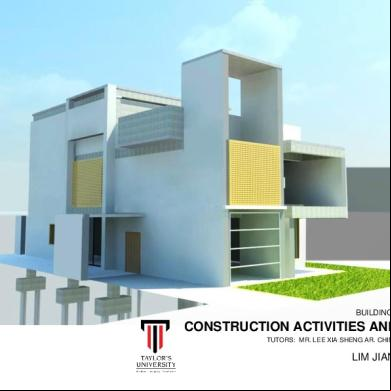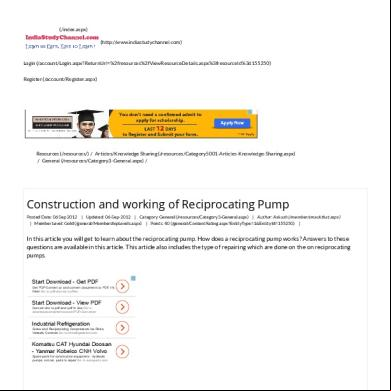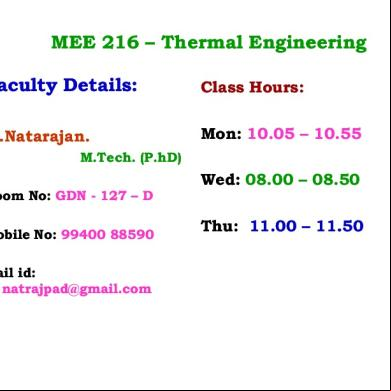Construction And Working Details Of Pultrusion Process z4q6f
This document was ed by and they confirmed that they have the permission to share it. If you are author or own the copyright of this book, please report to us by using this report form. Report 2z6p3t
Overview 5o1f4z
& View Construction And Working Details Of Pultrusion Process as PDF for free.
More details 6z3438
- Words: 385
- Pages: 19
Construction and working details of pultrusion process
BY PRAKASH C SPG 06 18 023
1
Contents Introduction to pultrusion Process setup Pultrusion reinforcements Pultrusion matrices
Consolidation Advantages and disadvantages Applications
2
Pultrusion Pultrusion is a continuous process for manufacture of composite materials with constant cross-section
Pulling of material such as Fiberglass and Resin, through a shaped and heated die. Pulforming - It is used to make elements which might be curved or may have variations in cross section throughout their lengths
3
Construction & working :
4
Description of Pultrusion Machine: Creel
Puller or driving mechanism
Resin wet out tank
Cut-off saw.
Forming dies
Mandrel
Heated matched metal die
5
Parts: Creel- Filament feeding, where in the fibers are unreeled from a creel (shelves with skewers that hold filament bobbins)
6
Resin wet out tank, where in the fibers are dipped in the uncured liquid resin Material : Sheet of aluminium and with a set of rollers
7
Preforming fixtures- the collection of filaments is gradually shaped into the approximate cross section desired Material : Fluorocarbon or ultra high molecular weight polyurethanes
8
Heated Dies - Chrome plated matched metal die Replica of the product Desired shapes – highly polished internal surfaces Thin section – Heat conduction
Thick section – RF and conduction
9
Pulling section Pulling - A pair of continuous caterpillar belts containing pads
cut by a cut-off wheel with SiC or diamond grits
10
Cutting section
Mechanial - SiC and Diamond grits Laser
11
Materials options : Pultrusion Reinforcements Fiberglass Carbon fiber Aramid fiber Pultrusion Matrices
Epoxy, Polyester Vinyl ester and phenolic
12
Working and Applications:
13
Applications of Pultrusion: Electrical application including transformers s in bridges and structures Automobiles Pipes and rods
14
Advantages: The process is suitable for mass production Fast and Economic Resin content can be accurately controlled Increased Strength (fiber processed under tension, straight fibers) Consistent Quality
15
Disadvantages: Limited to constant or near constant cross-section components Heated die costs can be high
16
References: www.nptel.com www.gurit.com www.libertypultrusions.com www.pultruders.com
17
Any Queries ?
18
Thank you
19
BY PRAKASH C SPG 06 18 023
1
Contents Introduction to pultrusion Process setup Pultrusion reinforcements Pultrusion matrices
Consolidation Advantages and disadvantages Applications
2
Pultrusion Pultrusion is a continuous process for manufacture of composite materials with constant cross-section
Pulling of material such as Fiberglass and Resin, through a shaped and heated die. Pulforming - It is used to make elements which might be curved or may have variations in cross section throughout their lengths
3
Construction & working :
4
Description of Pultrusion Machine: Creel
Puller or driving mechanism
Resin wet out tank
Cut-off saw.
Forming dies
Mandrel
Heated matched metal die
5
Parts: Creel- Filament feeding, where in the fibers are unreeled from a creel (shelves with skewers that hold filament bobbins)
6
Resin wet out tank, where in the fibers are dipped in the uncured liquid resin Material : Sheet of aluminium and with a set of rollers
7
Preforming fixtures- the collection of filaments is gradually shaped into the approximate cross section desired Material : Fluorocarbon or ultra high molecular weight polyurethanes
8
Heated Dies - Chrome plated matched metal die Replica of the product Desired shapes – highly polished internal surfaces Thin section – Heat conduction
Thick section – RF and conduction
9
Pulling section Pulling - A pair of continuous caterpillar belts containing pads
cut by a cut-off wheel with SiC or diamond grits
10
Cutting section
Mechanial - SiC and Diamond grits Laser
11
Materials options : Pultrusion Reinforcements Fiberglass Carbon fiber Aramid fiber Pultrusion Matrices
Epoxy, Polyester Vinyl ester and phenolic
12
Working and Applications:
13
Applications of Pultrusion: Electrical application including transformers s in bridges and structures Automobiles Pipes and rods
14
Advantages: The process is suitable for mass production Fast and Economic Resin content can be accurately controlled Increased Strength (fiber processed under tension, straight fibers) Consistent Quality
15
Disadvantages: Limited to constant or near constant cross-section components Heated die costs can be high
16
References: www.nptel.com www.gurit.com www.libertypultrusions.com www.pultruders.com
17
Any Queries ?
18
Thank you
19





